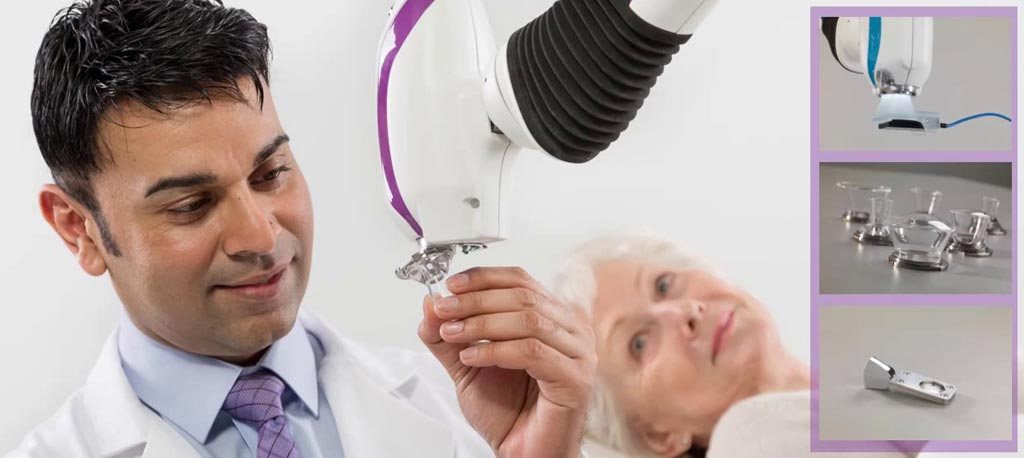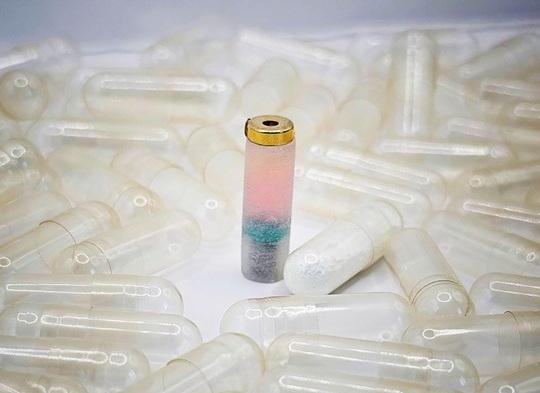Low-Cost System Provides an Alternative to Mohs Surgery
|
By HospiMedica International staff writers Posted on 15 Nov 2017 |

Image: An inexpensive photoelectric therapy system can replace invasive surgery (Photo courtesy of Xstrahl).
A novel photoelectric therapy system provides a pain free, non-surgical alternative for the treatment of non-melanoma skin cancer and superficial keloid lesions.
The Xstrahl (Camberley, United Kingdom) Photoelectric Therapy System is a mobile, compact, ergonomic superficial X-ray therapy system--operating in the 10-80kV range--designed for superficial radiotherapy and surface electronic brachytherapy of primary malignant epithelial neoplasms and keloids. Typical indications include basal and squamous cell carcinomas, metatypic carcinoma, cutaneous appendage carcinoma, Karposi's sarcoma, Merkel cell carcinoma, Lentigo maligna, Lentigo maligna melanoma, cutaneous lymphomas (B and T cell), and keloids.
Using a depth dose profile planned for the treatment of superficial skin lesions, the system utilizes low energy photons to deliver a high dose output, which enables treatment times to be kept to a minimum, whilst still treating a wide range of skin conditions. The low half-value layer (HVL) of the system allows for higher doses without compromising on depth of delivery, providing a pain free alternative to invasive procedure such as Mohs surgery, especially in lesions found in sensitive areas of the head and neck.
The freestanding, self-contained, unobtrusive, and lightweight system helps provide a reassuring and stress-free patient experience in any clinical facility. The ergonomically designed controls guarantee smooth adjustment and safe, simple patient set-up, and lockable castors guarantee free movement and operation in any clinical space. An added benefit is that photoelectric devices require minimal shielding and uses a 24 V power supply, in comparison higher energy X-ray therapy systems.
“In an era of personalized medicine, we should expect skin cancer treatment to be minimally invasive on the way we look,” said Amanda Tulk, business development director at Xstrahl. “At Xstrahl we have developed a solution that will enable more patients to gain access to a simple but effective and curative way to treat non-melanoma skin cancer.”
Most non-melanoma skin cancers are basal cell carcinoma, the commonest human cancer in Caucasians, and cutaneous squamous cell carcinoma; over 80% of these tumors occur on the skin of the head and neck, and most are easily curable. Death is rare; when it occurs, it does so from metastases’ or neglect. The major predisposing factor is chronic sunshine exposure, particularly in childhood; other factors include fair skin, ionizing radiation, immunosuppression, previous skin malignancy, and premalignant states, such as multiple actinic keratoses.
Related Links:
Xstrahl
The Xstrahl (Camberley, United Kingdom) Photoelectric Therapy System is a mobile, compact, ergonomic superficial X-ray therapy system--operating in the 10-80kV range--designed for superficial radiotherapy and surface electronic brachytherapy of primary malignant epithelial neoplasms and keloids. Typical indications include basal and squamous cell carcinomas, metatypic carcinoma, cutaneous appendage carcinoma, Karposi's sarcoma, Merkel cell carcinoma, Lentigo maligna, Lentigo maligna melanoma, cutaneous lymphomas (B and T cell), and keloids.
Using a depth dose profile planned for the treatment of superficial skin lesions, the system utilizes low energy photons to deliver a high dose output, which enables treatment times to be kept to a minimum, whilst still treating a wide range of skin conditions. The low half-value layer (HVL) of the system allows for higher doses without compromising on depth of delivery, providing a pain free alternative to invasive procedure such as Mohs surgery, especially in lesions found in sensitive areas of the head and neck.
The freestanding, self-contained, unobtrusive, and lightweight system helps provide a reassuring and stress-free patient experience in any clinical facility. The ergonomically designed controls guarantee smooth adjustment and safe, simple patient set-up, and lockable castors guarantee free movement and operation in any clinical space. An added benefit is that photoelectric devices require minimal shielding and uses a 24 V power supply, in comparison higher energy X-ray therapy systems.
“In an era of personalized medicine, we should expect skin cancer treatment to be minimally invasive on the way we look,” said Amanda Tulk, business development director at Xstrahl. “At Xstrahl we have developed a solution that will enable more patients to gain access to a simple but effective and curative way to treat non-melanoma skin cancer.”
Most non-melanoma skin cancers are basal cell carcinoma, the commonest human cancer in Caucasians, and cutaneous squamous cell carcinoma; over 80% of these tumors occur on the skin of the head and neck, and most are easily curable. Death is rare; when it occurs, it does so from metastases’ or neglect. The major predisposing factor is chronic sunshine exposure, particularly in childhood; other factors include fair skin, ionizing radiation, immunosuppression, previous skin malignancy, and premalignant states, such as multiple actinic keratoses.
Related Links:
Xstrahl
Latest Surgical Techniques News
- Minimally Invasive Endoscopic Surgery Improves Severe Stroke Outcomes
- Novel Glue Prevents Complications After Breast Cancer Surgery
- Breakthrough Brain Implant Enables Safer and More Precise Drug Delivery
- Bioadhesive Sponge Stops Uncontrolled Internal Bleeding During Surgery
- Revolutionary Nano Bone Material to Accelerate Surgery and Healing
- Superior Orthopedic Implants Combat Infections and Quicken Healing After Surgery
- Laser-Based Technique Eliminates Pancreatic Tumors While Protecting Healthy Tissue
- Surgical Treatment of Severe Carotid Artery Stenosis Benefits Blood-Brain Barrier
- Revolutionary Reusable Duodenoscope Introduces 68-Minute Sterilization
- World's First Transcatheter Smart Implant Monitors and Treats Congestion in Heart Failure
- Hybrid Endoscope Marks Breakthrough in Surgical Visualization
- Robot-Assisted Bronchoscope Diagnoses Tiniest and Hardest to Reach Lung Tumors
- Diamond-Titanium Device Paves Way for Smart Implants that Warn of Disease Progression
- 3D Printable Bio-Active Glass Could Serve as Bone Replacement Material
- Spider-Inspired Magnetic Soft Robots to Perform Minimally Invasive GI Tract Procedures
- Micro Imaging Device Paired with Endoscope Spots Cancers at Earlier Stage
Channels
Critical Care
view channel
AI Heart Attack Risk Assessment Tool Outperforms Existing Methods
For decades, doctors have relied on standardized scoring systems to assess patients with the most common type of heart attack—non-ST-elevation acute coronary syndrome (NSTE-ACS). The GRACE score, used... Read more
'Universal' Kidney to Match Any Blood Type
Blood-type incompatibility has long been one of the greatest obstacles in organ transplantation, forcing thousands of patients—particularly those with type O blood—to wait years longer for compatible donors.... Read morePatient Care
view channel
Revolutionary Automatic IV-Line Flushing Device to Enhance Infusion Care
More than 80% of in-hospital patients receive intravenous (IV) therapy. Every dose of IV medicine delivered in a small volume (<250 mL) infusion bag should be followed by subsequent flushing to ensure... Read more
VR Training Tool Combats Contamination of Portable Medical Equipment
Healthcare-associated infections (HAIs) impact one in every 31 patients, cause nearly 100,000 deaths each year, and cost USD 28.4 billion in direct medical expenses. Notably, up to 75% of these infections... Read more
Portable Biosensor Platform to Reduce Hospital-Acquired Infections
Approximately 4 million patients in the European Union acquire healthcare-associated infections (HAIs) or nosocomial infections each year, with around 37,000 deaths directly resulting from these infections,... Read moreFirst-Of-Its-Kind Portable Germicidal Light Technology Disinfects High-Touch Clinical Surfaces in Seconds
Reducing healthcare-acquired infections (HAIs) remains a pressing issue within global healthcare systems. In the United States alone, 1.7 million patients contract HAIs annually, leading to approximately... Read moreHealth IT
view channel
Printable Molecule-Selective Nanoparticles Enable Mass Production of Wearable Biosensors
The future of medicine is likely to focus on the personalization of healthcare—understanding exactly what an individual requires and delivering the appropriate combination of nutrients, metabolites, and... Read moreBusiness
view channel
Philips and Masimo Partner to Advance Patient Monitoring Measurement Technologies
Royal Philips (Amsterdam, Netherlands) and Masimo (Irvine, California, USA) have renewed their multi-year strategic collaboration, combining Philips’ expertise in patient monitoring with Masimo’s noninvasive... Read more
B. Braun Acquires Digital Microsurgery Company True Digital Surgery
The high-end microsurgery market in neurosurgery, spine, and ENT is undergoing a significant transformation. Traditional analog microscopes are giving way to digital exoscopes, which provide improved visualization,... Read more
CMEF 2025 to Promote Holistic and High-Quality Development of Medical and Health Industry
The 92nd China International Medical Equipment Fair (CMEF 2025) Autumn Exhibition is scheduled to be held from September 26 to 29 at the China Import and Export Fair Complex (Canton Fair Complex) in Guangzhou.... Read more














